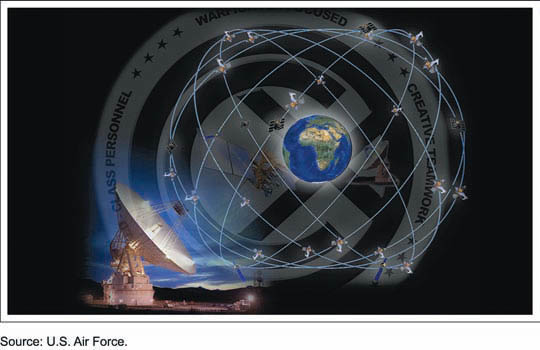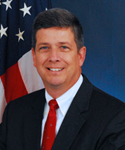 Jules McNeff, Overlook SystemsTechnologies, Inc.
Jules McNeff, Overlook SystemsTechnologies, Inc.EDITOR’S NOTE: Jules McNeff answers additional questions on the subject of spectrum protection and sharing in a special “GNSS Forum” extension of this installment of the "Thought Leadership Series" in this issue of Inside GNSS.
As Mark Twain once famously told a petitioner for investment advice: “Buy land. They are not making it any more.”
So it is with radio frequency spectrum, a limited and finite resource.
EDITOR’S NOTE: Jules McNeff answers additional questions on the subject of spectrum protection and sharing in a special “GNSS Forum” extension of this installment of the "Thought Leadership Series" in this issue of Inside GNSS.
As Mark Twain once famously told a petitioner for investment advice: “Buy land. They are not making it any more.”
So it is with radio frequency spectrum, a limited and finite resource.
The recent effort by LightSquared, Inc., to operate a potentially interfering wireless broadband service in frequencies adjacent to GPS L1 bands increased the GNSS community’s awareness of just how precious a resource spectrum is.
Given such pressures, a couple of concepts have emerged as ways to protect and “share” spectrum — specifically, the “harm claims threshold,” which would mandate that receivers be built to withstand a predetermined level of interference, and the “adjacent-band compatibility assessment,” which would give potential manufacturers of systems proposing to broadcast in neighboring frequencies clear limits so that they can test and plan accordingly.
To help sort out the technical and political issues surrounding this topic, we called on Jules McNeff. Now vice-president for strategy & programs at Overlook Systems Technologies, McNeff has a deep and lengthy background in GPS program operation and policy, including service in the Office of the Assistant Secretary of Defense with responsibility for the agency’s navigation systems policy and overall management and oversight of the GPS program.
IGM: What should the GNSS community’s posture be — both politically and technologically — in the context of increasing demands on RF spectrum in general and the concept of “sharing” spectrum in particular?
MCNEFF: Recognize and accept the reality that political pressures to “free up” spectrum for image- and video-content broadband communications applications will continue ahead of realistic technological solutions for GNSS. Also recognize that government spectrum regulators won’t be proactive in looking for ways to help the GNSS community fight such initiatives..
The GNSS community should act to shape the environment as it evolves and to take advantage of opportunities presented by multiple Radionavigation Satellite Service (space-to-earth) (RNSS) allocations rather than simply trying to block the initiatives. GNSS industry must commit to getting as much performance as possible from GNSS receivers operating within assigned RNSS spectrum and making use of all available GPS and other GNSS civil signals necessary to improve interference mitigation for specific applications, like safety-of-life.
Within the United States, the GPS industry should take the lead in developing consensus on an application-based receiver certification framework that focuses on specific GPS receiver types (both navigation and timing) used for safety and critical infrastructure — much as other industry associations have done. Perhaps the former U.S. GPS Industry Council, in its newest instantiation as the GPS Innovation Alliance, could begin this initiative among its membership.
Additionally, all GPS manufacturers and users must constantly remind government regulators of the unique nature of GPS- and GNSS-provided positioning, navigation, and timing (PNT) services from both technical and operational perspectives. Each perspective argues against the possibilities of “sharing” spectrum with other technologies, based either on frequency proximity or spectrum usage patterns, respectively.
Also, to help confront challenges from the broadband service providers, the GNSS community should consider advocacy initiatives to more directly advertise the benefits of precise PNT to high-data rate communications through their own employment of highly precise time and frequency synchronization from protected GNSS services. Clear and supportable quantitative arguments are most useful to roll back both commercial and regulatory reluctance to affording special consideration to GPS/GNSS signals and services.
IGM: In many important ways, GPS and GNSS signals differ from those of other RF technologies, particularly terrestrial wireless communications. Which differences are most relevant as regards spectrum allocation and use? Is there a way to incorporate these differences into the guidelines used to make decisions??
MCNEFF: It’s true, as the GPS/GNSS community well knows, that important differences in GNSS signal transmission and processing create spectrum challenges for RNSS allocations that are very different from typical communications services. In the case of GPS, signals are broadcast from the satellites such that the received signal at the earth’s surface is well below the noise floor and recovered by spread spectrum techniques. As such, the low power signal is subject to in-band interference and adjacent band effects that raise the noise floor or otherwise hinder signal reception. This can be true even if the source of interference is low-power, but proliferated in large quantities.
Also, unlike communications processors, a GPS receiver must not only recover the bits in the navigation message but also requires a level of “crispness” in the reception so that the receiver can use knowledge of bit transitions to determine elapsed time between transmission from the satellite and reception at the receiver. Wider bandwidth receivers produce crisper transitions and, hence, better precision. However, they run up against the limitations of the RNSS allocations and now, the influence of filtering effects at the band edges.
Opening receiver front ends beyond the RNSS allocations subjects them to out-of-band interference and receives no sympathy from either regulators or other spectrum users in adjacent bands. It’s fair to say that government regulators are generally reluctant to agree that these differences deserve consideration. Consequently, they do not feel a sense of obligation regarding the unique features of GPS/GNSS signals, and are inclined to treat them the same as communications systems. It is therefore up to the GPS/GNSS community to continue to educate spectrum regulators in every jurisdiction to the contrary.
IGM: What are the relative merits of the “harm claims threshold” and “adjacent-band compatibility” approaches and which would best serve the GNSS community?
MCNEFF: With respect to the harm claims threshold idea, my initial response is, “what is ‘harm’ exactly, who defines the ‘threshold,’ and for whom, and how do regulators propose to manage the result?”
Many different categories of receivers are operating with signals in the RNSS allocations (military, civil, commercial, and scientific). Each category, in turn, consists of many different receiver types/designs, and each has a different definition of “harm” and likely different “harm thresholds.” Also, should a particular “threshold” be determined, policing its implementation among an aggregation of interference sources claiming to “fit in” would be a monumental challenge and likely unworkable. It would certainly seem to operate to the detriment of those diverse GNSS receivers attempting to function within that “authorized” interference environment.
The adjacent-band compatibility assessment makes more sense on the surface, as long as it is equitably performed and takes account of the unique nature of RNSS services, as already mentioned. It is certainly possible to enable managed use of adjacent spectrum by satellite (space-to-earth) systems, by low-power, non-proliferated terrestrial transmitters, and even by higher power transmitters operated intermittently.
The principal objective of this approach should be to prohibit proliferation of high-powered systems in adjacent bands that would disrupt properly designed GNSS receivers operating within the RNSS allocations or of systems that would raise the noise floor within the RNSS allocation and impede reception of GNSS signals. If properly managed by the regulatory agencies, this approach would seem to best serve the GNSS community.






